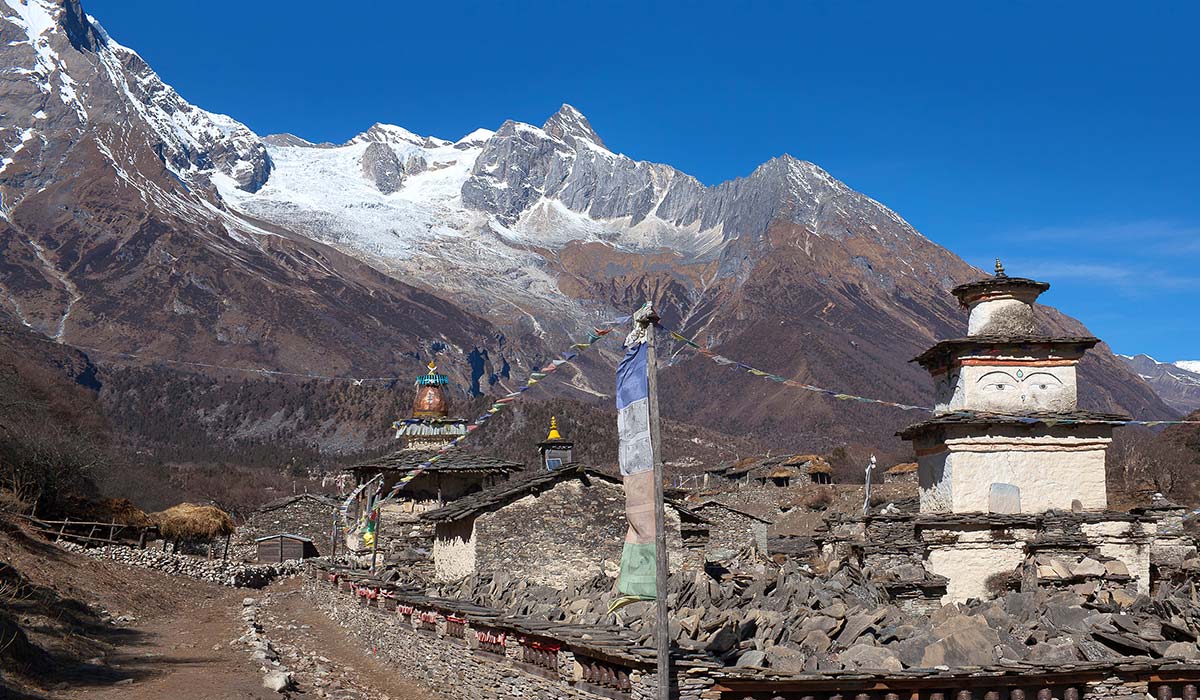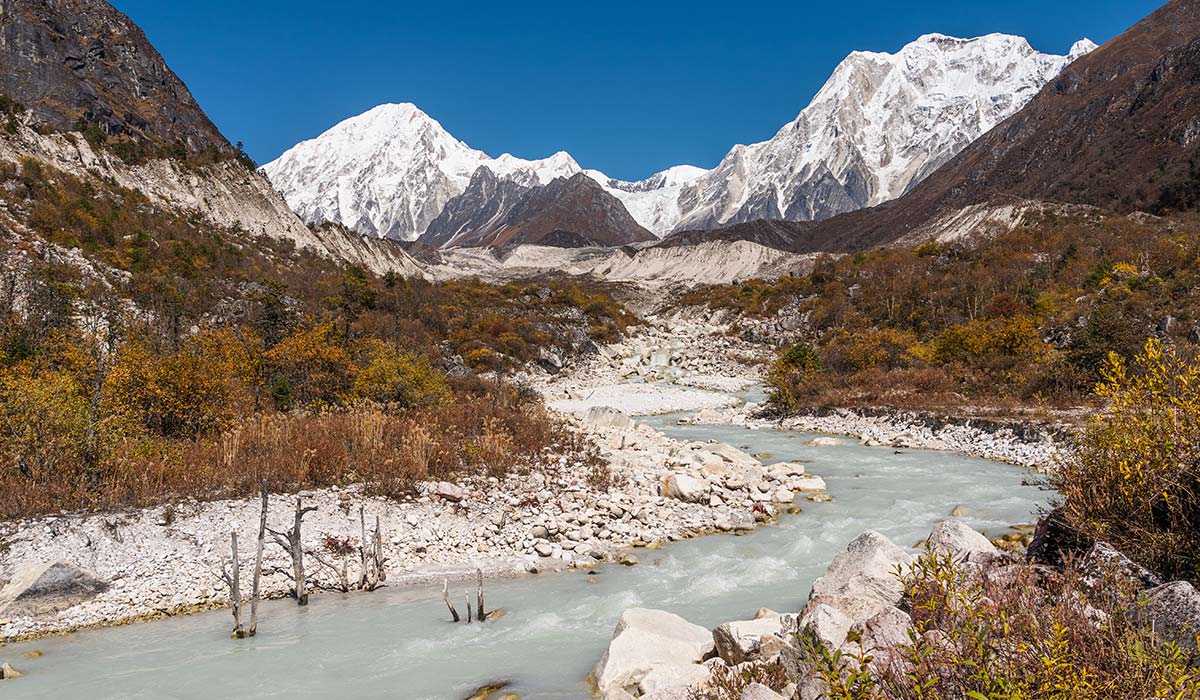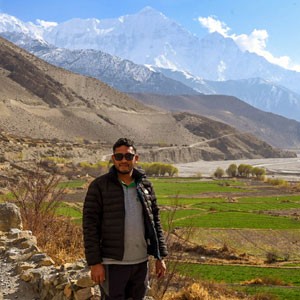Why Choose The Manaslu Circuit for Your First Treks?
Beginner-Friendly Climb
Manaslu Circuit is an easier trek unlike some of the Himalayan treks, which are only suited to experienced trekkers because of its extreme altitude as well as technical difficulty. If you are fit enough and well-prepared, at the trek’s highest point of 5,160 meters, Larkya La Pass will bring challenging, but doable goals.
Other trekking regions like Everest (8,848 meters) or Annapurna (5,416 meters), with more intensive elevation and difficult climb than Manaslu, require more advanced mountaineering skills. Manaslu Circuit allows beginners to taste the high altitude trekking in an accessible way as well as avoid overwhelming extreme conditions.
Gradual Ascent and Acclimatization
One of the important features that makes it best for beginners, is the gradual ascent. Trekkers will gradually ascend starting from low altitudes of 700 meters at Soti Khola, through dense forests and terrace farmlands, to ensure plenty of time for acclimatization.
Larkya La Pass, even though the highest point, which stands at 5,160 meters, can be achievable, if careful planning is done. At lower elevations, about 3,500 meters, Samagaon is a very good resting place where trekkers can acclimatize before tackling the last stretch to the pass. This mountain trek is made for gradual elevation gain with built in rest days, making it easier for beginners.
In addition, places like Samagaon and Samdo, aren't only for resting, but also acts as a cultural touchpoint to explore Tibetan Buddhist monasteries and stupas. The peacefulness of these areas and their slow incline makes it ideal for beginners, providing both physical adaptation and cultural immersion.
Well-Developed Infrastructure and Accommodations
Yet another reason why the Manaslu Circuit is one of the best trails to go for starters is that all along the route, there is well established infrastructure in place. Reliable food and rest stops are found in the network of teahouses, without needing excessive heavy packs or over complicated logistics. The accessibility of the trek makes it more easy, less stressful for beginners.
Also, local guides are present to help you with navigation, to share cultural insights and minimize the chance of altitude sickness by ensuring you acclimatize properly. Local guides offer peace of mind as safety and cultural understanding are always ready to have.

Packing Essentials and Gear Checklist
While packing for Manaslu Circuit trek, which is a high altitude trek with varying weather conditions, you need careful consideration to be well-prepared. If you’re a beginner, keep your packing list manageable and focus only on what is important.
Begin with moisture wicking clothing, merino wool or synthetic fabrics, making sure sweat doesn’t stay on your skin and avoid cold. Layering would be great for adjusting to varying temperatures, so pack a down jacket or fleece for warmth and a waterproof outer shell for rain or snow.
Waterproof trekking boots are a must for footwear, especially when you are crossing a stream. Wear thick woolen socks with those boots so that no blisters occur but warmth does. The quickly falling temperature at higher altitudes requires you to have a sleeping bag rated to -10°C to keep you comfortable.
It is important to be hydrated, so ensure you’re drinking clean water, for which you need to carry a water bottle or hydration bladder and a water purifier. Bringing a first aid kit, with antiseptic wipes, blister pads and any personal medication is also essential.
If you’re a beginner, trekking poles will keep you more stable especially on steep climbs. You need a headlamp for early morning starts or if you find yourself still walking after sunset. And finally, pack a small daypack for snacks, camera, and sunscreen, leaving your heavier pack at the teahouses.
By packing thoughtfully you’ll remain comfortable and well prepared for all challenges of the trek. Make sure your gear is lightweight but effective so you aren’t overburdened. An organized and prepared trek will result in it being a good and enjoyable trek.
Permits, Regulations, and Trekking Costs
Before starting the Manaslu Circuit, you need to obtain the relevant permits. As you will be trekking near the Tibetan border, a combination of Manaslu Conservation Area Permit (MCAP), Annapurna Conservation Area Permit (ACAP) and Restricted Area Permit (RAP) will be required to do the trek.
MCAP and ACAP is Rs. 100 per Nepali Citizen, USD 10 for SAARC Citizen, and
USD 30 for foreigners. The RAP costs USD 100 for the starting week, then USD 15 per day later from September to November. From December to August, the RAP only cost USD 75 for the first week, with USD 10 per day thereafter.
Securing permits may sound complicated, but in reality, it is pretty simple, and many trekkers find themselves a guide to help with this. The Restricted Area Permit requires the hiring of a guide, which is an indispensable expense to ensure your safety and enjoyment.
Not just with the logistics, but the guides also monitor acclimatization in order to prevent altitude sickness, and make sure you aren’t sick. Your trekking experience gets rich from their knowledge of the area’s history, culture, and geography.
Together with permits, you should also think about how much teahouse stays and meals will cost along the way. Accommodation costs on average USD 5 to 15 a night, and food is around the same price at USD 5 to 10, which can increase as you ascend in the remote areas. As for Guides, they usually charge USD 25 to 30 per day, which can be shared amongst the others in a group. You can expect to pay about USD 20 to 25 per day for porters.
The total cost for this 14 to 16 day trek varies from about USD 800 to 1,200 based on your particular choices of accommodation, guide, and meals. The cost covers all the necessary permits, the support of your guide, accommodation, and meals along the trail. With some careful budgeting you can have an amazing experience without spending a ton of money.
Accommodation and Food Along the Trail
The Manaslu Circuit trek has the majority of accommodation being warm tea houses that are welcoming to rest after a day’s trekking. To simplify logistics, staying in teahouses is great while still a beginner. Most of them are run by local families who provide basic, shared rooms with simple beds and shared bathrooms.
These teahouses are there to bring trekkers and though the facilities may be very basic, there is always a clean cozy and a sense of community along the way. Prices for them usually go from USD 5 to 15 per night, but higher altitudes will cost a little bit more.
The trek food is also simple, and nourishing, like Dal bhat, a traditional Nepali dish made from rice, lentil soup, and vegetables, is the most common meal. This hearty meal has enough carbohydrates and proteins to help nourish your body. Besides, there exists Tibetan inspired dishes such as momos (dumplings) and thukpa (noodle soup), which are perfect for cold evenings. They are appetizing and very easy to digest, best for high altitude trekking.
Variety like fried rice or noodles or pasta are in most teahouses for variety. In the evening, hot drinks such as tea, coffee, and hot chocolate are famous, which keep you warm and hydrated. Butter tea is a local specialty, a unique Tibetan drink consisting of tea, yak butter and salt, particularly useful for energy and hydration at higher elevations
Meeting fellow trekkers all over the world is the best part of staying in teahouses. When you’ve been hiking all day, a shared story and experience over a warm supper is the highlight of the long day. With the friendly hospitality and delicious food of the teahouses, the Manaslu Circuit becomes an enjoyable and comfortable trek for beginners.
Health, Safety, and Altitude Sickness Prevention
Trekking at high altitude like Manaslu Circuit at 5,160 meters can really exhaust your body as a beginner. To be safe on the trek, preparing yourself for altitude sickness is the most essential.
Acute mountain sickness (AMS), or altitude sickness, is when the body takes too long to adjust to the lack of oxygen in the air when you go to higher elevations. The symptoms are dizziness, nausea, headaches and shortness of breath.
You want to keep things on the slow side while trekking and take your time, as ascending slowly will reduce the risk. Despite the risks, the Manaslu Circuit is a beginner friendly trip as the route ascends slowly, allowing you sufficient time for acclimatization.
You will be able to rest a day or two when you stop at places like Samagaon(3,500 meters) and Samdo (3,875 meters) before climbing up to Larkya La Pass. By taking a break, you allow your body some time to adjust to the high altitude, thereby lowering your risk of having AMS.
If you experience any AMS symptoms while you are trying to climb, the number one rule is to make your way to a lower altitude immediately. Always listen to your body and don’t push yourself too far. If you are trekking at high altitudes, be sure to eat well, stay hydrated, avoid smoking and drinking alcohol.
Fitness wise, beginners who have reasonably good standards of general fitness will have no problem in completing trek. Although the Manaslu Circuit doesn’t require technical climbing skills, you should at least be able to cope with long walks with challenging bits and altitudes greater than 5,000 meters. If you have health conditions, like heart or respiratory problems, it’s best to talk to a doctor before you decide to start.
Guided vs. Solo Trekking: Best Options for Beginners
Solo trekking is not allowed for the Manaslu Circuit. Since 2011, the Nepalese government has made a policy, requiring all trekkers to be in a guided group for safety and conservation reasons.
As a beginner, guided trekking would offer various benefits. Trekking in isolated places, and high altitude areas likeManaslu can be tough, but having a local guide means you have a local expertise about the hard pathways you will travel, help you avoid altitude risks and tell you interesting things about the culture.
Guides help you with altitude acclimatization as well by preventing altitude sickness in the right way. In addition, guides are trained to deal with any emergencies that may occur and to contact local rescue services.
Many local guides also pass information about Tibetan Buddhism and the cultural heritage, adding to your trekking experiences. If you take a guide that can explain the significance of the monasteries and local customs when you go through Tibetan style villages such as Samagaon, the trek becomes much more enriching.
Manaslu's Circuit is not the easiest route for beginner trekkers, it is quite remote, and trekking alone could be dangerous. It is very highly recommended for beginners to trek with a guide, for safety and richer experience.
Cultural Etiquette and Responsible Trekking
Trekking in the Manaslu Circuit is a great chance to interact with local culture and Tibetan Buddhist practices, but do be respectful towards the region’s customs and traditions. At places like Samagaun and Lho communities, the community follows Buddhist traditions and are deeply rooted in religions.
A key point to note is, even if the amazing landscapes make you snap photos, be respectful and always ask permission before taking photos of people from the village, particularly those in rural villages or religious sites. Some find it disrespectful taking unsolicited photos, in particular, of locals in their regular day lives or during religious ceremonies. When you visit monasteries or temples, don’t dress flippantly or expose much.
Respect Religious Sites, monasteries along the Manaslu Base Camproute are sacred to local people. Only visit these sites by taking off your shoes, keeping quiet and not touching sacred objects unless invited to do so by a local. When it comes to stupas or prayer wheels, it’s customary to walk clockwise around them.
Respecting the environment and managing your waste, is also a part of responsible trekking. Take all trash with you and when available use the designated restrooms at tea houses or campsites. Manaslu Conservation Area is an environmentally protected region and visitors are requested to do their best to keep the site in pristine condition.
Finally, it is encouraged that you help locals in a respectful manner. If you want to directly donate or offer help, you should do it in a way that doesn’t interfere with the local economy or dynamics of the community. To help, you could support local businesses or make donations to community development projects.
Physical Preparation Tips for the Trek
For a successful Manaslu Circuit trek, you need to prepare your body for challenges of high altitude trekking. The highest point on this trek is Larkya La Pass, located 5,160 meters (16,930 feet). At this high altitude, the air has so little oxygen that without being prepared physically, it becomes difficult to handle the conditions. Physical preparation for beginners aids to prevent exhaustion, injuries, and altitude sickness. Here’s how to prepare effectively:
Cardiovascular Fitness
Building cardiovascular endurance is the first step toward preparation. Improving stamina will help when trekking at high altitudes as you need more energy. Do cardio exercises at least for 30 to 60 minutes a day for 3 to 4 days a week.
One useful thing is trying to walk on inclines and hiking trails similar to the terrain on the trek. This builds endurance and trains your body for the steep, long climbs and descents that you face in the steep section to Samdo, at 3,860 meters (12,664 feet).
Leg Strength
Each day you’re going to be hiking for hours with a backpack that weighs 8 to 12 kilograms, so you need to build leg strength. Perform exercise like squats, lunges and step-ups focusing on strengthening quadriceps, hamstrings, calves and glutes. It enables you to climb steep slopes such as Larkya La Pass ascend, which is a relatively physically demanding part of the trek. The more your legs are prepared, the easier you will feel to do these climbs.
Core Stability and Balance
Making balance on uneven surfaces requires core exercises, such as planks, and Russian twists. Rocky paths, forests, and narrow bridges make the Manaslu Circuit a trek where you need to stay stable. For the dangerous regions like Soti Khola to Samagaon stretch, core strength is useful in preventing falls.
Altitude Conditioning
Altitude training is not really necessary, but it will give you a huge benefit. Before your trek, spending time in higher altitudes (at least 2,500 meters/8,200 feet), prepares your body for acclimatization.
Having access to mountains to simulate the effects are pretty rare, instead you can use stair machines or hike with a backpack. Even a few days at high altitudes, in Kathmandu (1,400 meters/4,593 feet) or Pokhara (800 meters/2,625 feet) will help you acclimatize.
Training regularly by focusing on cardiovascular fitness, leg strength, core stability and altitude adaptation, will make you ready for the Manaslu trek. Acclimatization is a big part of the trek and especially important once you get up to altitudes like Samagaon, at 3500 meters (11,483 feet).
Take your time to rest and acclimatize to the altitude, and make sure you’re drinking enough water. With some preparation, the trek will be an amazing experience for beginners.

FAQ’s
1. What types of payment methods are accepted along the trail?
The primary payment method is cash. Larger villages such as Soti Khola have ATMs, but it’s always a good idea to carry plenty of Nepalese rupees as ATMs aren’t fully reliable. Credit or debit cards are almost rarely accepted.
2. Can I rent trekking gear locally if I forget something?
Of course you can rent trekking gear, such as sleeping bags and jackets, in Kathmandu or Soti Khola. But it’s always better just to bring your own stuff, especially your boots and clothes for high altitudes.
3. What is the phone network and connectivity like along the trek?
Major villages of Samagaon and Samdo have phone service being available using local SIM cards (NTC or Ncell). In remote areas, network coverage is the best, and Wi-Fi is slow at high altitudes, so remember to buy a local SIM at Kathmandu.
4. What are the best seasons for beginners to trek the Manaslu Circuit?
The best seasons are spring (March to May) and autumn (September to November) because of the clear skies, mild temperatures, and low amounts of rain.
5. What is the worst season for beginners to trek the Manaslu Circuit?
Monsoon (June to August) is the worst, as the rain is very heavy, the trails extremely muddy and availability of teahouses is low.
6. Why is winter not ideal for beginners?
In winter (December to February) the cold is extreme, as the temperatures drop often below -10°C, together with snowstorms and closed teahouses, that makes trekking very difficult.
7. How can I get the required Permits for the trek?
You need not worry about the issue of the permits as our agency takes care of it, in your package, but do bring your identity documents, and your citizenship copies.



